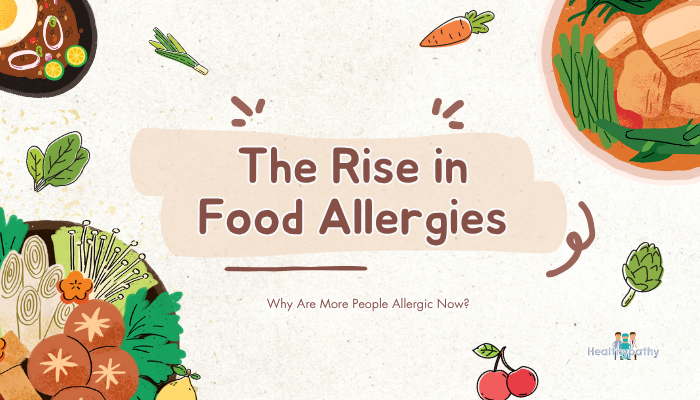Introduction
It seems like food allergies are more common than ever—young children avoiding peanuts, schools designating nut-free zones, and an abundance of “allergen-friendly” products on grocery shelves. But why are more people experiencing allergic reactions to foods that were once considered harmless? While no single explanation fully accounts for the increase, researchers point to several influences, including the hygiene hypothesis, shifts in dietary habits, and changes in gut microbiota. This guide explores the key factors fueling the rise in food allergies and offers insights on prevention and management.
Understanding Food Allergies
What Is a Food Allergy?
A food allergy occurs when the immune system mistakes a normally harmless food protein as a threat, producing an inflammatory response. Common food allergens include peanuts, tree nuts, milk, eggs, soy, wheat, fish, and shellfish. Symptoms can range from mild hives or stomach upset to severe reactions like anaphylaxis, which can be life-threatening.
Prevalence and Impact
Over the past few decades, numerous studies indicate a notable increase in the number of children and adults diagnosed with food allergies. The condition can significantly impact a person’s quality of life—requiring strict dietary vigilance to avoid accidental exposure and potential emergencies.
The Hygiene Hypothesis
How It Works
The hygiene hypothesis proposes that reduced early-life exposure to microbes or infectious agents—due to modern sanitation, antibiotics, and smaller family sizes—can alter immune development. A less “trained” immune system may overreact to harmless substances, like certain proteins in food.
Impact on Allergies
Because children now grow up in cleaner environments, their immune systems might lack the robust “practice” of differentiating harmful bacteria from harmless substances. This can lead to an immune system that’s more prone to allergic responses.
Changes in Diet and Food Processing
High-Processed Diets
Highly processed foods, preservatives, and additives can affect gut microbiome diversity. Some experts theorize that an imbalanced gut environment may predispose individuals to develop allergies—though exact mechanisms remain under investigation.
Early vs. Delayed Introduction
Older guidelines advised parents to delay introducing allergenic foods (e.g., peanuts) to infants. Newer research, however, suggests that early, controlled exposure may reduce the risk of developing allergies. Prolonged avoidance, on the other hand, might increase sensitivity.
Gut Microbiome and Its Role
Gut-Immune Connection
A healthy, diverse gut microbiome is crucial for immune regulation. When gut bacteria are out of balance (dysbiosis), it can lead to higher inflammation and potential misfires—like allergic reactions to proteins.
Antibiotics and Microbial Diversity
Frequent antibiotic use can disrupt the beneficial microbes in the GI tract, especially in early childhood, affecting how the immune system learns tolerance vs. reactivity. This disruption may open the door for allergic tendencies.
Possible Environmental Contributors
Pollutants and Toxins
Modern living includes exposure to airborne chemicals, pollutants, and microplastics. Some scientists suggest these may stress the immune system, leading to hyper-reactivity in the form of allergies.
Lifestyle Shifts
Less time outdoors, fewer farm or pet exposures, and a generally indoor-focused lifestyle can decrease contact with a variety of microbes. This “microbial scarcity” could steer an immune system toward allergic sensitivity.
Managing and Reducing Risks
Early Introduction of Allergenic Foods
Under professional guidance, offering small amounts of allergenic foods (like peanut butter) once a pediatrician deems it safe may foster tolerance in infants. Always consult with a healthcare professional, especially if there’s a family history of severe allergies.
Supporting Gut Health
- Breastfeeding (when possible) can help seed a healthy microbiome in infants.
- Fiber and Fermented Foods: Encourage beneficial microbes—e.g., yogurt, kefir, sauerkraut—supporting immune balance.
Mindful Antibiotic Use
Use antibiotics only when medically indicated. Overusing these medications can wipe out beneficial bacteria, potentially elevating allergy risks. For chronic or severe conditions, weigh the pros and cons with a healthcare provider.
Environmental Exposure
A bit of time outdoors, in nature, or with pets can diversify microbial encounters. While not a guarantee, this “natural inoculation” might help an immune system learn tolerance.
Frequently Asked Questions
Are food intolerances and food allergies the same?
No—intolerances (like lactose intolerance) primarily involve the digestive system; they don’t trigger the immune response that characterizes allergies. Allergies can provoke serious reactions, such as hives, throat swelling, or anaphylaxis.
Can I outgrow a childhood food allergy?
Some children outgrow allergies (e.g., milk or egg) as their immune system matures. However, allergies to peanuts, tree nuts, or shellfish often persist. Continuous monitoring by an allergist can clarify changes over time.
Do mild allergic reactions escalate with repeated exposure?
Potentially, yes. Allergy severity can shift unpredictably. Even if a reaction was mild once, future contact with the allergen might provoke more severe symptoms. Precautions (e.g., carrying an epinephrine auto-injector) are vital for those with known allergies.
Are “allergen-free” diets beneficial for those without confirmed allergies?
Eliminating entire food groups without evidence of allergy or intolerance can lead to nutritional deficits or a restricted diet. Always confirm sensitivities via medical tests rather than self-diagnosis.
Conclusion
While more research is needed to fully explain the rise in food allergies, factors like environmental hygiene, dietary patterns, and gut microbiome shifts likely contribute. Thankfully, steps like early controlled exposure to common allergens, supporting gut health, and cautious antibiotic usage may reduce the likelihood of developing allergies. For anyone suspecting an intolerance or allergy, consultation with healthcare professionals—like allergists or dietitians—ensures safe, informed management. With greater awareness and incremental changes, families and communities can tackle the challenge of rising allergies and help shape healthier, more tolerant immune systems in the next generation.
References
- National Institute of Allergy and Infectious Diseases (NIAID). Guidelines for the early introduction of allergenic foods.
- World Allergy Organization (WAO). Global strategy on food allergy.
- American Academy of Allergy, Asthma & Immunology (AAAAI). Hygiene hypothesis and allergies.
- Journal of Allergy and Clinical Immunology. Gut microbiome and food allergy.






